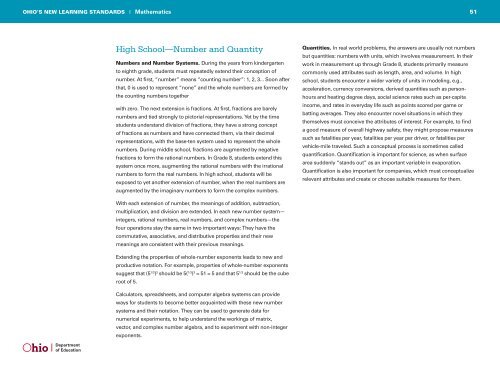Math-Standards.pdf
Math-Standards.pdf
Math-Standards.pdf
You also want an ePaper? Increase the reach of your titles
YUMPU automatically turns print PDFs into web optimized ePapers that Google loves.
OHIO’S NEW LEARNING STANDARDS I <strong>Math</strong>ematics 51<br />
High School—Number and Quantity<br />
Numbers and Number Systems. During the years from kindergarten<br />
to eighth grade, students must repeatedly extend their conception of<br />
number. At first, “number” means “counting number”: 1, 2, 3... Soon after<br />
that, 0 is used to represent “none” and the whole numbers are formed by<br />
the counting numbers together<br />
with zero. The next extension is fractions. At first, fractions are barely<br />
numbers and tied strongly to pictorial representations. Yet by the time<br />
students understand division of fractions, they have a strong concept<br />
of fractions as numbers and have connected them, via their decimal<br />
representations, with the base-ten system used to represent the whole<br />
numbers. During middle school, fractions are augmented by negative<br />
fractions to form the rational numbers. In Grade 8, students extend this<br />
system once more, augmenting the rational numbers with the irrational<br />
numbers to form the real numbers. In high school, students will be<br />
exposed to yet another extension of number, when the real numbers are<br />
augmented by the imaginary numbers to form the complex numbers.<br />
Quantities. In real world problems, the answers are usually not numbers<br />
but quantities: numbers with units, which involves measurement. In their<br />
work in measurement up through Grade 8, students primarily measure<br />
commonly used attributes such as length, area, and volume. In high<br />
school, students encounter a wider variety of units in modeling, e.g.,<br />
acceleration, currency conversions, derived quantities such as personhours<br />
and heating degree days, social science rates such as per-capita<br />
income, and rates in everyday life such as points scored per game or<br />
batting averages. They also encounter novel situations in which they<br />
themselves must conceive the attributes of interest. For example, to find<br />
a good measure of overall highway safety, they might propose measures<br />
such as fatalities per year, fatalities per year per driver, or fatalities per<br />
vehicle-mile traveled. Such a conceptual process is sometimes called<br />
quantification. Quantification is important for science, as when surface<br />
area suddenly “stands out” as an important variable in evaporation.<br />
Quantification is also important for companies, which must conceptualize<br />
relevant attributes and create or choose suitable measures for them.<br />
With each extension of number, the meanings of addition, subtraction,<br />
multiplication, and division are extended. In each new number system—<br />
integers, rational numbers, real numbers, and complex numbers—the<br />
four operations stay the same in two important ways: They have the<br />
commutative, associative, and distributive properties and their new<br />
meanings are consistent with their previous meanings.<br />
Extending the properties of whole-number exponents leads to new and<br />
productive notation. For example, properties of whole-number exponents<br />
suggest that (5 1/3 ) 3 should be 5( 1/3 ) 3 = 51 = 5 and that 5 1/3 should be the cube<br />
root of 5.<br />
Calculators, spreadsheets, and computer algebra systems can provide<br />
ways for students to become better acquainted with these new number<br />
systems and their notation. They can be used to generate data for<br />
numerical experiments, to help understand the workings of matrix,<br />
vector, and complex number algebra, and to experiment with non-integer<br />
exponents.


